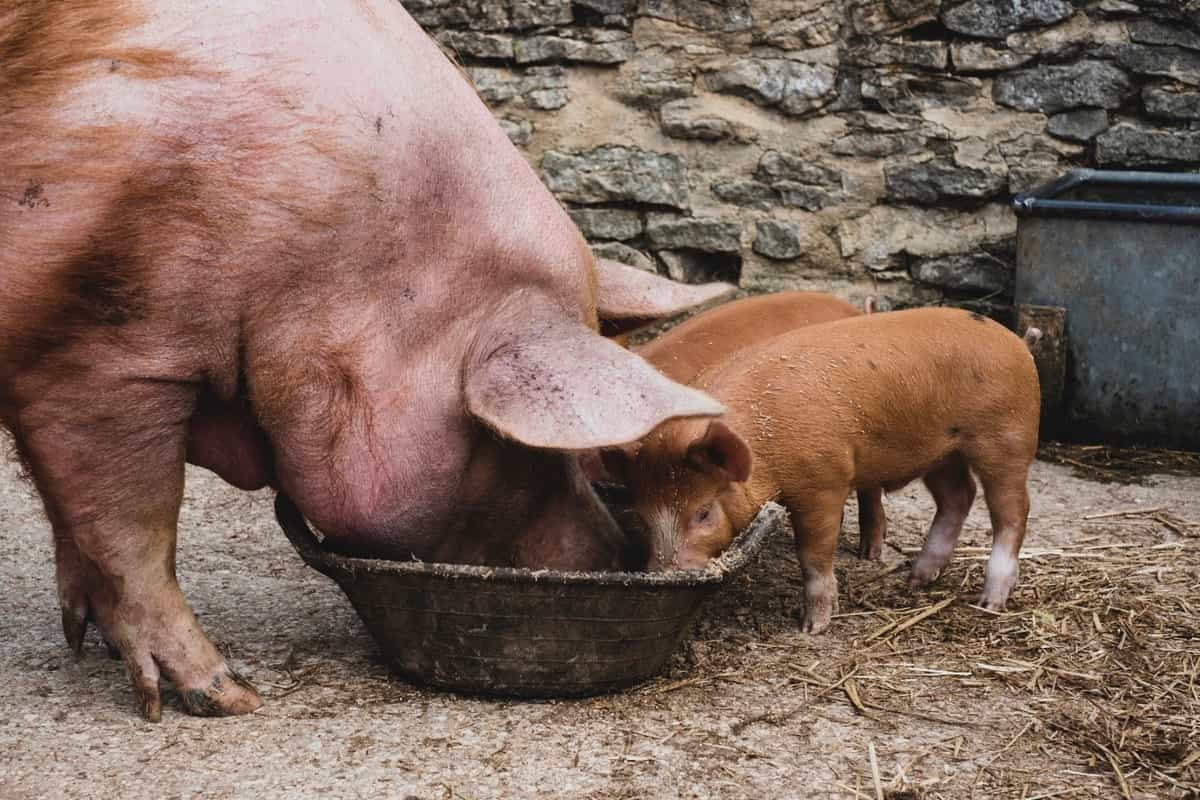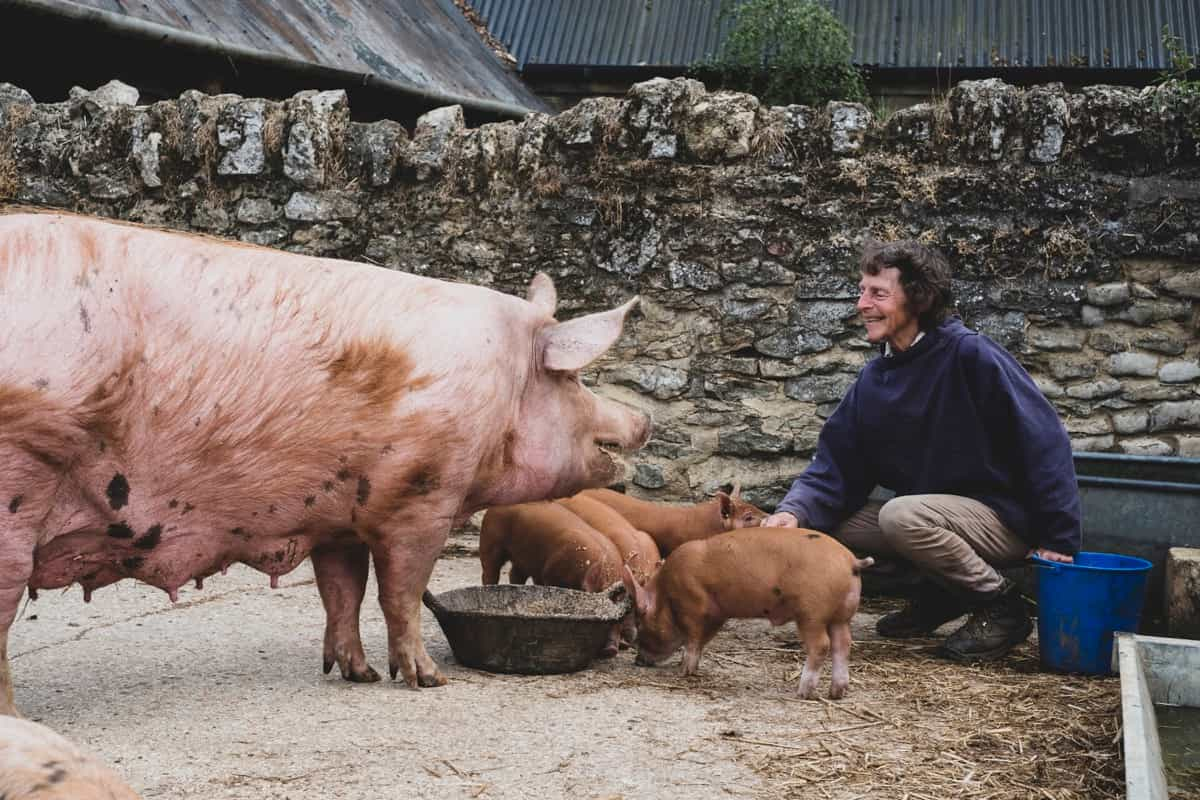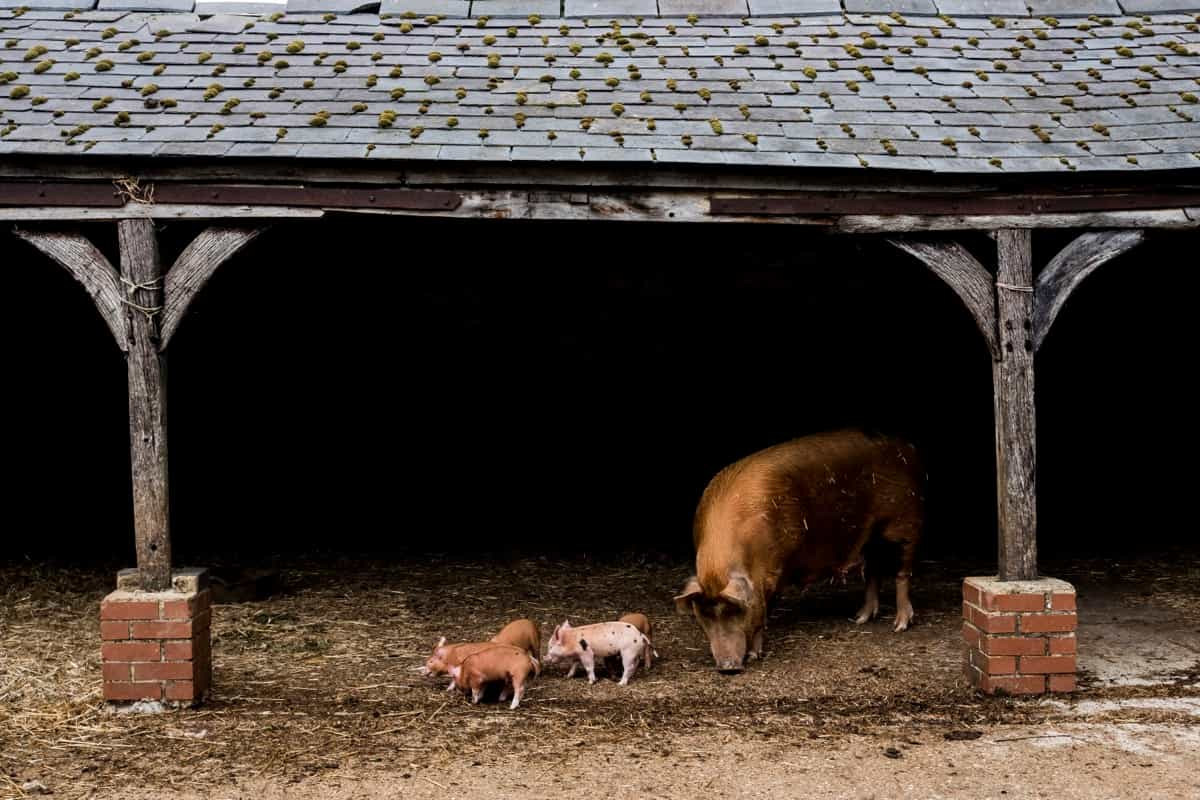The Tamworth pig breed is a fascinating and unique British domestic pig. It is one of the oldest pig breeds and one of the rarest in the world. Tamworth pigs are quite remarkable. They have a lean build with long legs and a strong frame. Their most distinguishing feature is their bright ginger or red-colored hair that covers their entire body. This gives them a strikingly beautiful appearance that sets them apart from other breeds.

History and Origins of the Tamworth Pig
The history and origins of the Tamworth pig breed trace back to Sir Robert Peel’s Drayton Manor Estate in Tamworth, Staffordshire, United Kingdom. This distinctive breed was developed with the influence of Irish pigs and eventually named after its place of origin. During the early 19th century, Sir Robert Peel initiated a breeding program on his estate to create a hardy and resilient pig breed. He introduced Irish pigs into the mix due to their reputation for being strong and adaptable.
These Irish pigs contributed to the developing of what is now known as the Tamworth pig. Over time, this new breed gained popularity for its unique characteristics and qualities. The Tamworth became valued for its ability to thrive outdoors in various climates, making it an ideal choice for farmers looking for sturdy livestock. The Tamworth pig remains one of the oldest and rarest breeds globally. Its rich history connects us to our agricultural roots while reminding us of preserving heritage breeds like these.
Physical Characteristics and Appearance of Tamworth Pigs
Tamworth pigs are known for their distinctive ginger coloration. They have long, lean bodies with strong, muscular frames. One look at a Tamworth pig, and you’ll notice their erect ears that stand tall on their heads. Is Tamworth pig farming profitable? Yes, raising these pigs is a very profitable business.
Their snouts are slightly upturned, giving them an inquisitive expression as they root around the ground for food. The snout is one of their most important features, as it helps them search for roots, bulbs, and insects in the soil. These pigs also have strong legs that allow them to move quickly and efficiently.
Temperament and Behavior of Tamworth Pigs
Known for their intelligence and curiosity, these pigs are often described as lively and alert. They are highly adaptable to different environments and thrive in various farming systems. One main characteristic of Tamworth pigs is their strong foraging instinct. They possess instincts for rooting, grazing, and exploring the outdoors. This makes them excellent free-range or pasture-raised animals, as they enjoy spending time outdoors searching for food.
Tamworths are generally docile and friendly towards humans if properly socialized from a young age. However, they still retain some wild traits due to their ancient lineage. It’s important to handle them with care and respect their space. Another interesting aspect of their behavior is their vocalization. Tamworths are known to be quite expressive through grunts, squeals, snorts, and even growls when they feel threatened or excited. What is the lifespan of Tamworth pigs? Naturally, Tamworth pigs can live for about 6-10 years.
Information about Tamworth Pig Breed
| Breed Name | Tamworth |
| Breed Size | Medium to large |
| Boars | 200 to 300 kg |
| Sows | 250 to 370 kg |
| Climate Tolerance | All climates |
| Rarity | Vulnerable |
| Country/Place of Origin | United Kingdom |
In case you missed it: Hereford Pig Breed Facts: Physical Characteristics, Origin, Temperament, and Breeding

Tamworth Pig Size/ Weight
Tamworth pigs, known for their distinctive ginger coat, are considered a medium-sized breed in the world . When it comes to weight, a full-grown boar can range anywhere from 250 to 370 kilograms (550 to 820 pounds), while a mature sow typically weighs between 200 and 300 kilograms (440 to 660 pounds). These numbers may vary slightly depending on factors such as genetics and diet.
In terms of length, adult Tamworths measure anywhere from 100 to 140 centimeters (39 to 55 inches). They have a sturdy build with common heights ranging from about 50 to 65 centimeters (20 to 26 inches). These measurements give them an elegant yet robust appearance characteristic of the breed. It’s important to note that size and weight can also depend on individual pig care practices.
Proper nutrition and ample exercise space can contribute significantly towards healthy growth and development in Tamworth pigs. So, whether you’re raising these beautiful creatures for meat or simply enjoying their company on your farm, understanding their physical characteristics is essential in providing them with the care they need.
Breeding and Reproduction in Tamworth Pigs
Breeding and reproduction play a crucial role in maintaining the population of Tamworth pigs. These hardy animals are known for their fertility and ability to adapt to different environments. Selecting healthy and genetically diverse pigs is essential when it comes to breeding. Tamworth sows mature at around 6-8 months, while boars become sexually active between 5-7 months. Breeding can be initiated by introducing a boar to a receptive sow or through artificial insemination.
Sows have an average gestation period of Tamworth pig of around 114 days, after which they give birth to litters ranging from 8-12 piglets. Ensuring proper nutrition during breeding is important as it directly affects reproductive performance. Regular veterinary check-ups are recommended during pregnancy to monitor the sow’s and developing piglets’ health. It’s also crucial to provide suitable housing conditions that offer comfort and protection during this sensitive time.
Feeding and Nutrition Requirements for Tamworth Pigs
Tamworth pigs are known for their excellent foraging abilities. They have a strong instinct to root around and search for food, making them well-suited for free-range environments. However, when it comes to feeding, they still require a balanced diet to ensure optimal health and growth. In addition to commercial pig feed, Tamworths also benefit from having access to pasture or grazing areas where they can supplement their diet with grasses, roots, insects, and other natural food sources.
In case you missed it: Project Report on Pig Farming: Cost and Profit Analysis

This allows them to exhibit their natural behaviors while obtaining additional nutrients. Fresh water should always be available for the pigs, as hydration is crucial for their well-being. Clean water helps with digestion and regulates body temperature. It’s worth noting that overfeeding can lead to obesity in Tamworth pigs which can cause various health problems. Therefore, it’s important not only to monitor the quantity but also the quality of food given.
Common Diseases in Tamworth Pigs
One common disease that affects Tamworth pigs is swine fever. This highly contagious viral infection can cause high fevers, loss of appetite, and even death in severe cases. Maintaining strict biosecurity measures on the farm is crucial to prevent this disease. Another health concern for Tamworth pigs is respiratory infections. Various bacteria or viruses can cause these, resulting in coughing, sneezing, nasal discharge, and difficulty breathing. Proper ventilation and hygiene practices are essential in preventing the transmission of these infections.
Parasites are another issue that pig owners need to address. External parasites like lice and mites can cause discomfort and skin irritation for the animals. Regular grooming, cleaning of living areas, and treating with appropriate medications or insecticides can help keep these pests at bay. Internal parasites such as worms also threaten Tamworth pigs’ health. Worm infestations can lead to weight loss, poor growth rates, anemia, diarrhea, and overall weakness in affected animals. Regular deworming programs should be implemented under veterinary guidance.
Foot problems have been observed among Tamworth pigs due to improper flooring or unsanitary environments, making it easy for bacterial infections to thrive, leading to hoof deformities such as abscesses or lameness. Awareness of common diseases that may affect them allows farmers and breeders better preparedness and timely prevention strategies, including regular vaccinations, good hygiene practices, and maintaining a clean environment for the pigs to thrive and live.
Tamworth Pig Disadvantages
One of the main disadvantages of Tamworth pigs is their slow growth rate compared to other commercial pig breeds. They take longer to reach market weight, resulting in higher feed costs and longer time investment for farmers. Their slower growth may make them less profitable for those looking for a quick turnaround. Another disadvantage is that Tamworth pigs are known to have leaner meat compared to some other pig breeds. While health-conscious consumers see this as an advantage, it may not appeal to those who prefer juicier and more marbled pork cuts.
In case you missed it: Baudin Pig Facts: Origin, Size, Physical Characteristics, Pros, and Cons

Furthermore, their outdoor nature and active behavior require ample space and access to pasture or woodland areas. Raising them in urban or confined settings may not be suitable or practical. Because the Tamworth breed is relatively rare and considered a heritage breed, finding breeding stock may prove challenging for prospective farmers. Limited availability could restrict opportunities for expansion or maintaining genetic diversity within herds.
Conclusion
Tamworth pigs are known for being active and intelligent animals with curious personalities. Beyond their physical attributes, understanding the temperament and behavior of Tamworth pigs is crucial for anyone considering raising them. These animals are known for being active and intelligent. They exhibit curiosity towards their surroundings but can also be strong-willed at times.
- Feed Your Flock for Less: Top 10 Tips to Save on Chicken Feed
- Ultimate Guide to Ossabaw Island Hog: Breeding, Raising, Diet, and Care
- Hatching Answers: The Top 10 Reasons Your Chickens Aren’t Laying Eggs
- Eggs and Economics: Breaking Down the Cost of Raising Backyard Chickens
- Defend Your Greens: Proven Methods to Keep Iguanas Out of Your Garden
- Ultimate Guide to Cinnamon Queen Chicken: A Comprehensive Guide for Beginners
- Ultimate Guide to California Tan Chicken: Breeding, Raising, Diet, Egg-Production and Care
- Ultimate Guide to Marsh Daisy Chicken: Breeding, Raising, Diet, and Care
- 10 Types of Chicken Farming Businesses You Can Start for Profits